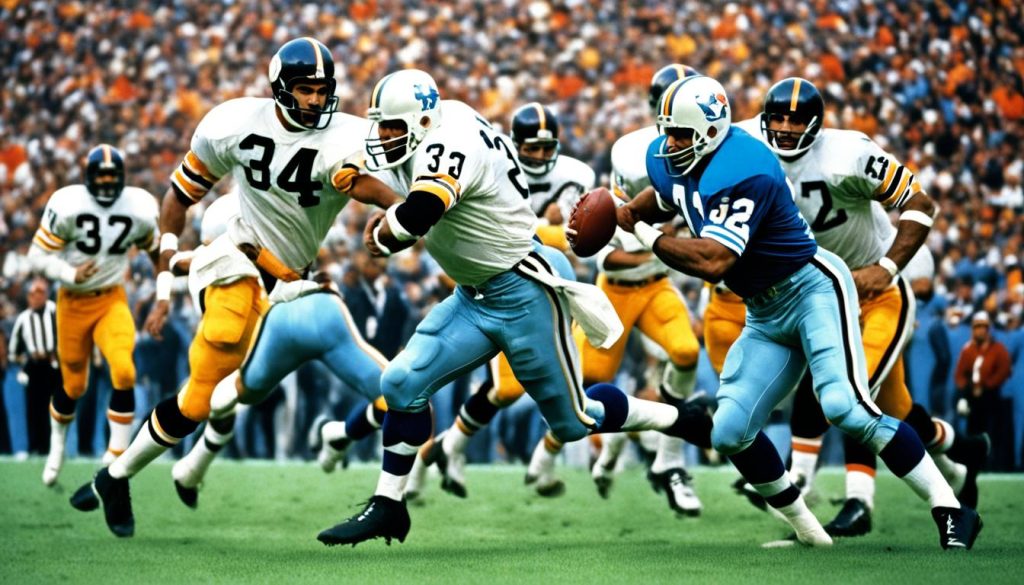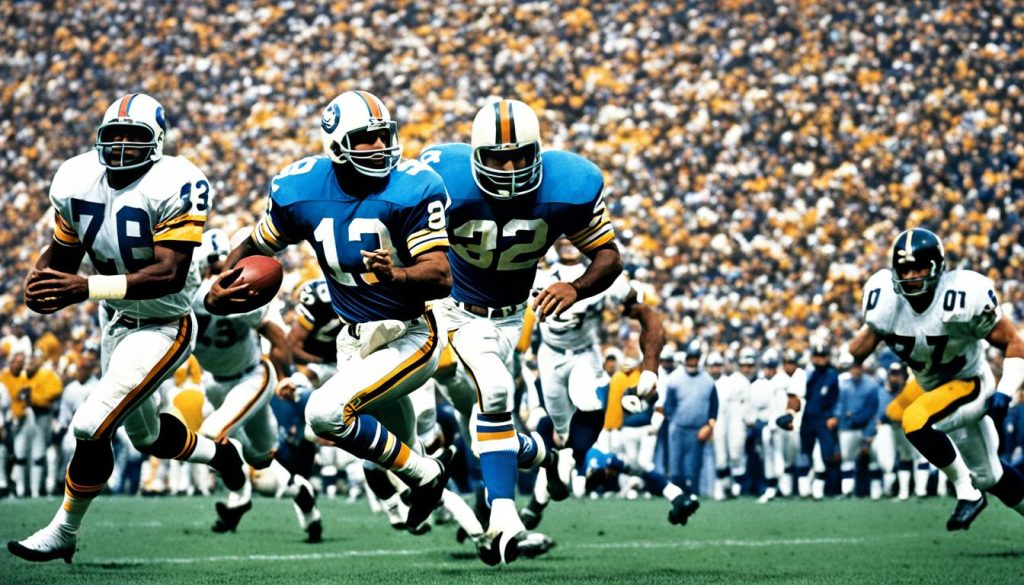Franco Harris vs. Earl Campbell: Who Was the More Dominant Running Back?
Do you remember the heyday of NFL when running backs ruled the game? Groundbreaking athletes like Franco Harris and Earl Campbell, altered the course of the sport and became iconic football players. Their legends etch deep into the cornerstones of NFL history boosting their glory beyond the realms of typical Hall of Fame comparison.
Here is an astonishing fact: Franco Harris garnered an incredible 12,120 rushing yards in his illustrious career. Quite shockingly, Earl Campbell, acknowledged for his crushing running style, amassed an exceptional 9,407 yards in his considerably shorter career. Imagine a NFL running backs head-to-head where the careers of these two powerhouses is scrutinized, their high-octane performances dissected, and their considerable impacts assessed.
This comparison between Franco Harris and Earl Campbell is not merely a contest of statistics, but an exploration into their undeniable influence on the game. How about we dive deep into this NFL history showdown?
Buckle up as we plunge into a captivating journey revisiting their careers, assessing their dominance, the underlying significance, and the undying legacy they’ve imprinted on the beloved sport.
Key Takeaways
- Both Franco Harris and Earl Campbell are recognized as iconic football players in NFL history.
- Their individual careers, boosted by their iconic status, usher new perspective to traditional Hall of Fame comparison.
- Harris garnered an impressive 12,120 rushing yards during his career making him an unforgettable running back legend.
- Campbell, known for his strong running style, accumulated significant 9,407 yards over a shorter career span.
- Both players imprinted an immutable legacy on the sport, influencing succeeding generations of NFL running backs.
- Going beyond raw statistics, their comparison provides an in-depth understanding of individual dominance and overall game impact.
Exploring the Careers of Franco Harris and Earl Campbell
Stepping into the NFL, Pittsburgh Steelers’ Franco Harris and Houston Oilers’ Earl Campbell brought their collegial successes to the ultimate showcase of football. Their individual journeys from early years, transition to NFL, and remarkable peak performance years to eventual retirement undeniably scripted an NFL history showdown worthy of revisiting.

Early Years and Entry into the NFL
Every great career has a starting point. For Franco Harris, it began in the gritty city of Pittsburgh, where he was drafted by the Steelers. Earl Campbell’s journey, on the other hand, commenced in the heart of Texas with the Houston Oilers. Both had impressive collegiate careers, which set the stage for their entry into the NFL.
Peak Performance Years
The peak performance years of both players were more than just a spectacle; they became a defining part of their legacy. Harris, with his unique blend of power and agility, tormented opposing defenses, racking up rushing statistics that still rank among the best in Steelers’ history. Similarly, Campbell’s powerful running style and breakaway speed made him a nightmare for any defender attempting to bring him down, an indelible part of the Oilers’ legacy.
Career Longevity and Retirement
Celebrating the longevity of a player’s career is honoring the strength of their fortitude, and both Harris and Campbell exhibited plenty. Taking different paths yet achieving remarkable longevity, Franco Harris reigned in comparison to many of his contemporaries, including other greats like Marcus Allen. Unfortunately for Campbell, injuries saw a premature close to his career, yet his achievements within a truncated time frame etched his name among the all-time greats.
| Players | Years Played in NFL | NFL Teams Played For | Rushing Yards Career Total |
|---|---|---|---|
| Earl Campbell | 1978 – 1985 | Houston Oilers, New Orleans Saints | 9407 yards |
| Franco Harris | 1972 – 1984 | Pittsburgh Steelers, Seattle Seahawks | 12120 yards |
Franco Harris vs. Earl Campbell: Rushing Statistics Breakdown
As we delve deeper into the distinction between two legendary running backs, Franco Harris and Earl Campbell, we must sieve through their remarkable stats. Both had compelling careers, their performance possesses a critical role in the annals of the NFL history showdown. Let’s break down their rushing statistics, to glean a quantitative understanding of their dominance on the field.

Franco Harris
-
Number of Seasons: 13
-
Total Rushing Yards: 12,120
-
Touchdowns: 91
-
Yards per game: 70.9
Earl Campbell
-
Number of Seasons: 9
-
Total Rushing Yards: 9,407
-
Touchdowns: 74
-
Yards per game: 81.8
Despite playing fewer seasons due to injury, Campbell’s rushing statistics were extraordinary. His five seasons with over 1,300 rushing yards and his remarkable total, despite a career limited to just 115 games, is evidence of his indomitable presence on the field.
On the other hand, Harris— who holds his own with over 12,000 total rushing yards and an impressive 91 touchdowns— showcased consistent performance over his 13-year tenure with the Pittsburgh Steelers.
Their monumental contributions underline the great question: Franco Harris or Earl Campbell—who ruled the roost among these legendary running backs in the NFL history showdown?
Impact on NFL History and the Evolution of the Running Back
As the game has evolved over the years, marked by shifting paradigms of athleticism and strategy, the landscape of the NFL has been ever-transforming. The role of running backs, particularly, has seen a dramatic metamorphosis. Let’s dive into the changing roles of running backs over the decades, highlighting the legendary Franco Harris and Earl Campbell’s enduring impacts around which NFL lore revolves.
Changing Roles of Running Backs Over the Decades
The running back’s role has always been crucial, but their exact duties have seen considerable shifts over time. The ground-and-pound style that dominated the 70s and 80s gave way to a more balanced approach in the following decades.
- 70s and 80s: Workhorse running backs like Franco Harris and Earl Campbell were in their prime, collecting hard-fought yards up the middle.
- 90s and 00s: Running backs evolved to being dual threats as they increased their receiving contributions in addition to their running duties.
- 2010 onwards: The modern NFL sees running backs as diverse offensive weapons, often lining up as wide receivers and even running routes.
Legacy of Harris and Campbell in NFL Lore
The strides of time may alter the paradigm, but running backs like Franco Harris and Earl Campbell have left an indelible legacy. Iconic football players like these have forwarded the evolutionary role of running backs, with their respective styles informing the DNA of the position.
| Franco Harris | Earl Campbell | |
|---|---|---|
| Playing Style | Powerful runner, hard to bring down, clutch performer in big games | Brutishly strong, possessed astonishing speed for a man of his size, synonymous with toughness |
| NFL Impact | Spearheaded Pittsburgh Steelers to four Super Bowl titles, rejuvenating the franchise’s fortunes and setting a then-unprecedented standard of success | Transformed Houston Oilers from a struggling team into divisional champions, won the NFL MVP in his rookie year, brought grit and willpower to the game |
Through their performances and contributions, these iconic players have influenced the generations to come, bridging the transitions of their playing days to shape the contemporary evaluations of the running back position. They carved out their unique niches in NFL history, forever altering how the game is perceived and played. This legacy of evolution and impact is the true testament to their greatness.
Awards and Accolades: Hall of Fame Comparison
When considering stat-studded careers of legendary running backs, individual achievements and team success have dramatic impacts on their overall legacy. As two of the most iconic athletes in American football, Franco Harris and Earl Campbell’s contributions have not been overlooked by the Hall of Fame. It’s worth noting that these NFL giants had radically different careers and thus, received remarkably varied recognitions and awards.
Individual Honors and Achievements
Individual honors and accolades tell a part of the story, intimating the strength and value of a player to the sport. Tomlinson and Sanders’ records are distinguished by unmatched consistency and unprecedented feats, earning them countless honors during their careers.
| Pro Bowls | All-Pro Selections | MVP Awards | Offensive Player of the Year | |
|---|---|---|---|---|
| Franco Harris | 9 | 1 | 0 | 0 |
| Earl Campbell | 5 | 3 | 1 | 2 |
Evidently, Campbell’s hallmark achievement of an MVP Award certainly marks him out as one of the all-time greats. Furthermore, his three All-Pro selections further bolster his personal success. In contrast, while Harris may not boast of an MVP title, his nine Pro-Bowl appearances are nothing short of remarkable and exemplify his prolonged consistency.
Team Success and Contributions
While individual accolades are impressive, they don’t fully underscore a player’s impact within the team framework. For, it is in guiding a team to championships that players truly etch their legacy. Hence, comparing Harris and Campbell’s contributions to team success provides more context.
| Super Bowl Championships | Playoff Appearances | Conference Championships | |
|---|---|---|---|
| Franco Harris | 4 | 12 | 4 |
| Earl Campbell | 0 | 5 | 0 |
When it comes to team success, the Hall of Fame comparison leans heavily in favor of Harris. His contribution in leading the Pittsburgh Steelers to four Super Bowl Championships and to twelve playoff appearances is a superb testament to his team impact, putting him ahead of Campbell’s five playoff appearances with the Oilers.
The Significance of Supporting Cast in Shaping Careers
When it comes to success on the football field, particularly for running backs, a lot more goes into it than individual talent. A key component that is often overlooked is the supporting cast — the teammates, coaches, and offensive lines that surround a player. Both Franco Harris of the Pittsburgh Steelers and Earl Campbell of the Houston Oilers are prime examples of this phenomenon. The success they achieved throughout their illustrious careers can be largely credited to the environment they played in and the dynamic of their respective teams.
Key Teammates and Offensive Lines
While Harris and Campbell were torchbearers on the field, their supporting cast played a significant role in shaping their careers. The strength of a running back’s offensive line can directly influence their performance, ability to gain yards, and ultimately, their role in leading their team to victory. The offensive lines of the Pittsburgh Steelers and the Houston Oilers were instrumental in paving the way for Harris and Campbell’s success, helping them to rack-up impressive statistics and establish themselves as some of the greatest running backs in NFL history.
The Role of Team Dynamics
The culture and dynamics of a team also play a critical role in shaping a player’s career. How a team works together, supports each other, and reacts to challenging situations can have a profound influence on individual players. In the case of Harris and Campbell, each navigated unique team dynamics to leverage their talents and achieve greatness. This goes to show that creating a solid, cohesive team dynamic is just as important as fostering individual skill on the path to football success.
